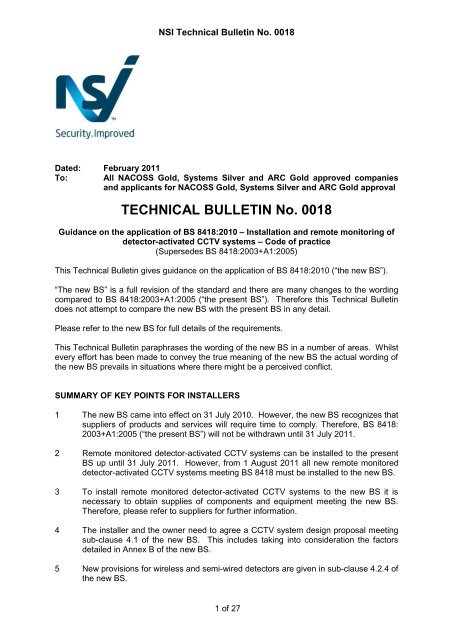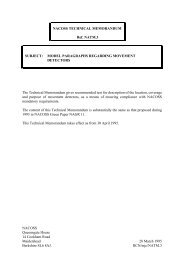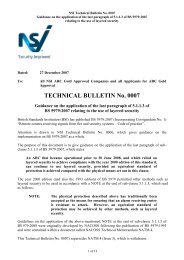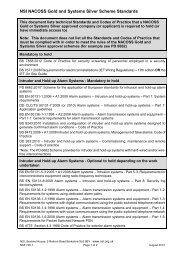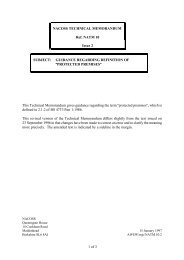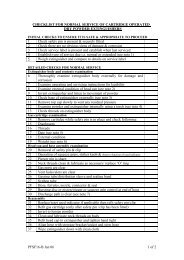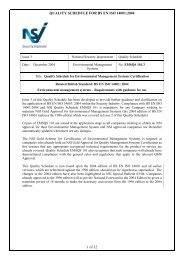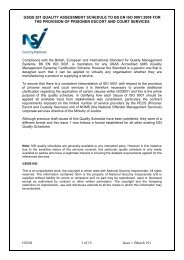TECHNICAL BULLETIN No. 0018
TECHNICAL BULLETIN No. 0018
TECHNICAL BULLETIN No. 0018
Create successful ePaper yourself
Turn your PDF publications into a flip-book with our unique Google optimized e-Paper software.
NSI Technical Bulletin <strong>No</strong>. <strong>0018</strong><br />
Dated: February 2011<br />
To: All NACOSS Gold, Systems Silver and ARC Gold approved companies<br />
and applicants for NACOSS Gold, Systems Silver and ARC Gold approval<br />
<strong>TECHNICAL</strong> <strong>BULLETIN</strong> <strong>No</strong>. <strong>0018</strong><br />
Guidance on the application of BS 8418:2010 – Installation and remote monitoring of<br />
detector-activated CCTV systems – Code of practice<br />
(Supersedes BS 8418:2003+A1:2005)<br />
This Technical Bulletin gives guidance on the application of BS 8418:2010 (“the new BS”).<br />
“The new BS” is a full revision of the standard and there are many changes to the wording<br />
compared to BS 8418:2003+A1:2005 (“the present BS”). Therefore this Technical Bulletin<br />
does not attempt to compare the new BS with the present BS in any detail.<br />
Please refer to the new BS for full details of the requirements.<br />
This Technical Bulletin paraphrases the wording of the new BS in a number of areas. Whilst<br />
every effort has been made to convey the true meaning of the new BS the actual wording of<br />
the new BS prevails in situations where there might be a perceived conflict.<br />
SUMMARY OF KEY POINTS FOR INSTALLERS<br />
1 The new BS came into effect on 31 July 2010. However, the new BS recognizes that<br />
suppliers of products and services will require time to comply. Therefore, BS 8418:<br />
2003+A1:2005 (“the present BS”) will not be withdrawn until 31 July 2011.<br />
2 Remote monitored detector-activated CCTV systems can be installed to the present<br />
BS up until 31 July 2011. However, from 1 August 2011 all new remote monitored<br />
detector-activated CCTV systems meeting BS 8418 must be installed to the new BS.<br />
3 To install remote monitored detector-activated CCTV systems to the new BS it is<br />
necessary to obtain supplies of components and equipment meeting the new BS.<br />
Therefore, please refer to suppliers for further information.<br />
4 The installer and the owner need to agree a CCTV system design proposal meeting<br />
sub-clause 4.1 of the new BS. This includes taking into consideration the factors<br />
detailed in Annex B of the new BS.<br />
5 New provisions for wireless and semi-wired detectors are given in sub-clause 4.2.4 of<br />
the new BS.<br />
1 of 27
NSI Technical Bulletin <strong>No</strong>. <strong>0018</strong><br />
6 New provisions for omitting and isolating detectors are given in sub-clauses 4.5.3<br />
and 4.5.4 of the new BS respectively.<br />
7 Two data transmission paths need to be provided except where wireless technology<br />
is the only possible means of communication – see sub-clause 4.5.9 of the new BS.<br />
8 An uninterruptible power supply (UPS) needs to power the CCTV control equipment<br />
and communications devices for a minimum period of 4 hours if mains power fails (or<br />
for a minimum period of 30 minutes if mains power fails and a standby generator is<br />
provided) – see sub-clause 4.5.12 of the new BS.<br />
9 Power supplies to detectors need to supply power for a minimum of 4 hours – see<br />
sub-clause 4.5.12.4 of the new BS.<br />
10 Power supplies to detectors need to be monitored for failure. Failures need to be<br />
reported to the RVRC and/or indicated audibly at the protected premises – see subclause<br />
4.5.12.5 of the new BS.<br />
11 Commissioning needs to meet Clause 6 of the new BS and a commissioning<br />
checklist meeting Annex E of the new BS needs to be followed.<br />
12 There needs to be liaison with the owner/user on completion of the installation (see<br />
sub-clause 6.9 of the new BS). A signature from the owner acknowledging receipt of<br />
operating instructions needs to be obtained.<br />
13 A documented agreement for maintenance needs to be in place before the CCTV<br />
system is accepted for monitoring. Routine maintenance visits need to be carried out<br />
at least twice per year. The RVRC can carry out one of these visits remotely – see<br />
sub-clause 14.1.1 of the new BS.<br />
14 The owner and the maintenance provider must agree documented criteria for<br />
maintenance or repair of the CCTV system and these criteria need to be<br />
communicated to the RVRC – see sub-clause 14.1.1 of the new BS.<br />
SUMMARY OF KEY POINTS FOR RVRCs<br />
A<br />
B<br />
C<br />
D<br />
E<br />
The new BS came into effect on 31 July 2010. However, the new BS recognizes that<br />
suppliers of products and services will require time to comply. Therefore, the present<br />
BS will not be withdrawn until 31 July 2011.<br />
If an RVRC takes on the monitoring of a CCTV system meeting the new BS then the<br />
monitoring of that CCTV system must also meet the new BS.<br />
From 1 August 2011, RVRCs must monitor all BS 8418 CCTV systems to the new<br />
BS irrespective of whether the systems are installed to the present BS or the new<br />
BS. This is except for sub-clause 11.4 of the new BS – see item G below.<br />
The RVRC needs to compare source images with relevant stored reference images<br />
at least once every six months – see sub-clause 6.4.3 of the new BS.<br />
There needs to be a documented agreement between the owner and the RVRC<br />
detailing owner responsibilities (see sub-clause 8.1 of the new BS). This includes the<br />
actions the RVRC needs to take in response to CCTV system failures (see subclause<br />
8.5 of the new BS).<br />
2 of 27
NSI Technical Bulletin <strong>No</strong>. <strong>0018</strong><br />
F<br />
G<br />
There needs to be a documented agreement between the owner and the RVRC in<br />
the form of a response plan detailing the actions to be taken by the RVRC upon<br />
receipt of activations – see sub-clause 8.3 of the new BS.<br />
Digital CCTV recording systems (DCRS) need to meet BS 8495 if images may be<br />
required as evidence for a crime (see sub-clause 11.4 of the new BS).<br />
<strong>No</strong>te: Meeting sub-clause 10.4 of the present BS is acceptable for CCTV systems<br />
installed to the present BS.<br />
H<br />
The RVRC must carry out maintenance meeting sub-clause 14.1.3 of the new BS.<br />
CONTENT<br />
The following Table illustrates how the content of the present BS compares with the new BS.<br />
TABLE 1 – Comparison of content of BS 8418:2003+A1:2005 and BS 8418:2010<br />
BS 8418:2003+A1:2005 BS 8418:2010<br />
1 Scope 1 Scope<br />
2 <strong>No</strong>rmative references 2 <strong>No</strong>rmative references<br />
3 Terms, definitions and<br />
abbreviations<br />
4 CCTV system design<br />
and installation<br />
3 Terms, definitions and abbreviations<br />
4 CCTV system design<br />
5 Installation<br />
5 Commissioning 6 Commissioning<br />
6 Site operational<br />
procedures<br />
7 Setting/unsetting procedures of the CCTV system on<br />
the protected premises<br />
7 Owner responsibilities 8 Owner responsibilities and considerations<br />
8 RVRC operator<br />
procedures<br />
9 RVRC specifications 10 RVRC<br />
9 RVRC operator procedures<br />
10 RVRC procedures 11 RVRC procedures and documentation<br />
11 Activation management 12 Activation management<br />
12 Service levels 13 Service levels<br />
13 General 14 General maintenance and personnel screening<br />
Annex A: Setting procedure<br />
in the active state<br />
Annex A: Diagrams for positioning detectors<br />
Annex B: Factors affecting the design requirements for a<br />
CCTV system<br />
Annex C: Types of technology used in detection equipment<br />
Annex D: Illumination of the field of view of the camera<br />
Annex E: Checklist criteria for the commissioning of a<br />
CCTV system<br />
Annex F: Setting procedure with a detector in the active<br />
state<br />
3 of 27
NSI Technical Bulletin <strong>No</strong>. <strong>0018</strong><br />
DETAILS ABOUT THE NEW BS<br />
Details about the new BS are given below according the relevant clause of the new BS.<br />
Guidance or comment about the new BS is given in italics.<br />
1 SCOPE (Clause 1 of the present BS)<br />
The standard gives recommendations for the design, installation, commissioning, operation<br />
and remote monitoring of detector-activated CCTV systems.<br />
The standard gives recommendations to the following parties:<br />
a) Installers and maintenance providers on best practice for the design, installation,<br />
commissioning and operation of detector-activated CCTV systems.<br />
This includes the installation and maintenance engineers working for the installers<br />
and maintenance providers.<br />
b) Remote video response centres (RVRCs) monitoring CCTV systems.<br />
c) Owners and users regarding the management of CCTV systems.<br />
The following table illustrates how the standard applies to installers, RVRCs and owners. It<br />
illustrates how all parties need to work closely together in order to meet the new BS.<br />
In the table, the term “installer” means “maintenance provider” where applicable. Also the<br />
term “owner” means “user” where applicable.<br />
TABLE 2 – Application of BS 8418:2010 to installers, RVRCs and owners<br />
Clause Content Applies to<br />
1 Scope Installer, RVRC and owner<br />
2 <strong>No</strong>rmative references Installer and RVRC<br />
3 Terms, definitions and abbreviations Installer, RVRC and owner<br />
4 CCTV system design Installer and owner<br />
5 Installation Installer<br />
6 Commissioning Installer, RVRC and owner<br />
7 Setting/unsetting procedures Installer, owner and RVRC<br />
8 Owner responsibilities and considerations Owner, RVRC and installer<br />
9 RVRC operator procedures RVRC and owner<br />
10 RVRC RVRC and installer<br />
11 RVRC procedures and documentation RVRC, owner and installer<br />
12 Activation management RVRC<br />
13 Service levels RVRC<br />
14.1 CCTV system maintenance Installer, RVRC and owner<br />
14.2 Personnel screening Installer and RVRC<br />
4 of 27
NSI Technical Bulletin <strong>No</strong>. <strong>0018</strong><br />
2 NORMATIVE REFERENCES (Clause 2 of the present BS)<br />
The normative references given in the new BS are as follows:<br />
BS 5979, Remote centres receiving signals from fire and security systems<br />
BS 7671, Requirements for electrical installations – IEE wiring regulations<br />
BS 7858, Security screening of individuals employed in a security environment<br />
BS 7958:2009, Closed-circuit television (CCTV) – Management and operation<br />
BS 8495, Code of practice for digital CCTV recording systems for the purpose of image<br />
export to be used as evidence<br />
BS EN 50132‐7, Alarm systems – CCTV surveillance systems for use in security<br />
applications – Part 7: Application guidelines<br />
3 TERMS, DEFINITIONS AND ABBREVIATIONS (Clause 3 of the present BS)<br />
Please refer to the new BS for full details of the terms, definitions and abbreviations.<br />
4 CCTV SYSTEM DESIGN (Clause 4 of the present BS)<br />
4.1 CCTV system design proposal<br />
The installer needs to agree a CCTV system design proposal with the owner which<br />
includes the following:<br />
a) Diagram(s) showing the position of all cameras, detectors and their fields of<br />
view, the extent of the secure area, designated locations of parked vehicles<br />
and other movable objects or materials that could compromise the<br />
effectiveness of the CCTV system, and actual dimensions where drawings<br />
are not drawn to scale.<br />
b) Type, location, mounting height and brief technical specification of cameras<br />
and lenses.<br />
c) Type, location, mounting height, direction, range and brief technical<br />
specification of detectors.<br />
This should include information regarding dormant periods after activation.<br />
d) Identity of functional camera presets which are associated with detectors and<br />
the identity of the detectors with which they are associated.<br />
e) Identity of fixed cameras associated with detectors and the identity of<br />
detectors.<br />
f) Type and locations of any audio devices.<br />
5 of 27
NSI Technical Bulletin <strong>No</strong>. <strong>0018</strong><br />
g) Data transmission paths used by the CCTV system, with details of the parties<br />
responsible for their implementation and their continuing provision and<br />
maintenance.<br />
h) Artificial illumination provided, with details of the parties responsible for its<br />
implementation.<br />
i) Location and brief technical specification of components such as controls,<br />
power supplies and storage devices.<br />
j) Services for which the owner is responsible with details of the user<br />
responsibilities for correct operation of the CCTV system.<br />
The factors given in Annex B of the new BS need be taken into consideration when creating<br />
a CCTV system design proposal. These include:<br />
<br />
<br />
<br />
<br />
<br />
<br />
<br />
detector configuration<br />
expected movement within a secure area<br />
conditions of the secure area<br />
environmental factors<br />
geographic location<br />
sources of heat<br />
open sites<br />
4.2 Detector positioning and configuration<br />
Except in cases where it would be inappropriate to have a camera covering the detection<br />
area created by the detector, the detection areas need to be such that activations occur in<br />
areas within the fields of view of the cameras.<br />
Annex A of the new BS provides diagrams illustrating the correct positioning of detectors.<br />
An example of where it would normally be considered inappropriate to have a camera<br />
covering a detection area is where a detector is installed inside public toilets.<br />
The RVRC and the owner need to have an agreement regarding the expected response at<br />
the RVRC in cases where detectors include outputs for transmitting information to the CCTV<br />
control equipment about their status.<br />
The secure area needs to be divided into multiple detection zones with detectors positioned<br />
so that events that are detected result in activations.<br />
Detectors need to be positioned so that:<br />
<br />
<br />
movement outside the secure area is not detected<br />
they are not affected by the rising or setting of the sun<br />
Detectors need to:<br />
<br />
<br />
meet specified requirements, such as detection range, and they need to be selected<br />
to minimize unwanted activations<br />
be adjustable in both the vertical and horizontal axis<br />
6 of 27
NSI Technical Bulletin <strong>No</strong>. <strong>0018</strong><br />
Annex C of the new BS gives useful guidance on the types of technology used in detection<br />
equipment including:<br />
<br />
<br />
<br />
<br />
<br />
<br />
<br />
<br />
<br />
passive infra-red receiver<br />
active infra-red receiver<br />
microwave<br />
laser<br />
video analytics<br />
video motion detection<br />
perimeter fence protection<br />
buried sensor technology<br />
combined technology (which can help to avoid unwanted activations)<br />
Manufacturer’s recommendations need to be followed to ensure the correct operation of<br />
detectors.<br />
Where multiple detectors are connected to a single input they must be individually identified<br />
by the CCTV control equipment, for example by individual IP addresses.<br />
The following functions need to be provided where wireless and/or semi-wired detectors are<br />
used:<br />
a) An indication for low battery voltage, which needs to be reported to the RVRC<br />
in the set condition.<br />
b) An indication for loss of wireless signal, which needs to be reported to the<br />
RVRC in the set condition.<br />
c) The fault conditions in a) and b) above also need to be indicated at the<br />
protected premises in both the set and unset conditions together with<br />
indications of the individual detector(s) that are affected.<br />
d) An indication for a failed communication link via an output signal (one per<br />
channel) sent by the receiver.<br />
e) A unique identification code assigned to a dedicated channel on the receiver<br />
identifying transmission devices belonging to the CCTV system.<br />
f) A communication protocol, secure from unintentional or intentional data<br />
substitution. This should include 10,000,000 or more variations of<br />
identification codes, randomly generated by the CCTV system.<br />
It is not necessary to indicate individual detector faults at the RVRC.<br />
4.3 Camera positioning and configuration<br />
Attention is drawn to Part 33 of Schedule 2 of the Town and Country Planning (General<br />
Permitted Development) Order 1995.<br />
4.3.1 General<br />
Camera positioning and configuration of the CCTV system needs to meet BS EN 50132-7.<br />
Cameras need to be positioned so that:<br />
7 of 27
NSI Technical Bulletin <strong>No</strong>. <strong>0018</strong><br />
<br />
the areas covered by detectors are viewed<br />
This ties in exactly with the need for detection areas to fall within the fields of view of<br />
the CCTV cameras (see 4.2 above).<br />
<br />
they are not affected by the rising or setting of the sun<br />
Fields of view need to be set up to achieve the desired results based on a 1.6 metre high<br />
target (which is roughly the average height of a human being).<br />
For example to detect an event the field of view should be such that a 1.6 metre high target<br />
fills at least 10% of screen height.<br />
The following Table gives four examples of desired results.<br />
TABLE 3 – Percentage of screen height filled by target to achieve desired objective<br />
Desired<br />
Results<br />
Percentage of<br />
Screen Height<br />
Explanation<br />
Detection At least 10% Detection (referred to in the new BS as verification)<br />
means that the operator viewing the display screens is<br />
able to determine with a high degree of certainty whether<br />
or not a human being is present.<br />
Observation 25% to 30% Observation means that the operator viewing the display<br />
screens is able to see some characteristic details of the<br />
individual, such as distinctive clothing, whilst also being<br />
able to see some activity surrounding the incident being<br />
viewed.<br />
Recognition At least 50% Recognition means that the operator viewing the display<br />
screen is able to determine with a high degree of certainty<br />
whether or not an individual shown is the same as<br />
someone they have seen before.<br />
Identification At least 100%<br />
Identification means that with the target now occupying at<br />
least 100% of the screen height, picture quality and detail<br />
is sufficient to enable the identity of an individual to be<br />
established beyond reasonable doubt.<br />
The percentage figures above are taken from Home Office Scientific Development Branch<br />
Publication <strong>No</strong>. 28/09 – “CCTV Operational Requirements Manual 2009”.<br />
The entry/exit route needs to be viewed by a fixed camera or by a functional (PTZ) camera<br />
in its parked position.<br />
Where functional (PTZ) cameras are the sole means of viewing the area, they need to be<br />
treated as multi-position fixed cameras through the use of defined presets rather than<br />
infinitely variable devices.<br />
Where functional (PTZ) cameras using preset positions in association with alarm devices are<br />
deployed, any facility to alter the preset positions needs to be restricted to the installer<br />
and/or the RVRC.<br />
Wherever possible, cameras must not overlook public areas.<br />
8 of 27
NSI Technical Bulletin <strong>No</strong>. <strong>0018</strong><br />
Attention is drawn to the guidance on Data Protection given in the CCTV Code of Practice<br />
2008 published by the Information Commissioner’s Office (see www.ico.gov.uk).<br />
All CCTV system equipment needs to be fit for purpose and be able to withstand prevailing<br />
environmental conditions.<br />
Cameras need to be:<br />
<br />
<br />
uniquely identified using a name or label that is displayed at the RVRC and<br />
corresponds to the name or label shown on the protected premises plan (see also<br />
sub-clause 9.1.3 of the new BS)<br />
checked on configuration to ensure that they are able to focus during the day and at<br />
night<br />
4.3.2 Illumination<br />
The detection areas covered by cameras need to be illuminated so that the desired results<br />
(see Table 3 above) can be achieved.<br />
Annex D of the new BS gives information about illuminating the field of view of a camera.<br />
Artificial illumination:<br />
<br />
<br />
<br />
needs to be provided when other sources of illumination are insufficient to achieve<br />
the desired results<br />
needs to be maintained in accordance with manufacturer’s instructions<br />
must not face cameras in such a way as to impede the clarity of images<br />
Infrared illumination on external cameras must not surround the camera lens.<br />
The RVRC operator must report artificial illumination failures and other illumination problems<br />
to the owner within 24 hours of their discovery. The owner is then responsible for ensuring<br />
that illumination failures and problems are rectified in accordance with the documented<br />
agreement with the RVRC (see sub-clause 8.5 of the new BS).<br />
The owner is responsible for making periodic checks of the illumination at intervals not<br />
exceeding 96 hours.<br />
Clocks used to control illumination need to be adjusted in relation to British Summer Time<br />
(BST) changes. The responsibility for making these changes must be agreed contractually<br />
between the RVRC, the owner and the company providing maintenance.<br />
4.4 Audio challenge<br />
Audio challenge facilities need to be:<br />
<br />
<br />
clearly audible, without undue distortion<br />
within the area of coverage of the relevant detectors (as indicated in the CCTV<br />
system design proposal)<br />
9 of 27
NSI Technical Bulletin <strong>No</strong>. <strong>0018</strong><br />
Audio challenges must be initiated by the RVRC and may consist of pre-recorded or live<br />
voice operation.<br />
Attention is drawn to the Clean Neighbourhoods and Environment Act 2005. The ACPO<br />
policy on police response to security systems requires audio challenge facilities to be<br />
included and care needs to be taken to minimize noise disturbance to the environment.<br />
4.5 CCTV system performance and integrity<br />
4.5.1 Activation performance<br />
Activations must initiate within 1 second of an event being detected.<br />
4.5.2 Video transmission system<br />
The video transmission system must be capable of sending continuous video images to the<br />
RVRC while the RVRC operator is evaluating images.<br />
4.5.3 Detector omission<br />
There needs to be a documented agreement between the owner and the RVRC in<br />
accordance with sub-clause 8.1 of the new BS. This agreement needs to include procedures<br />
for omitting detectors.<br />
The term “omission” can be compared to the term “inhibit” in BS EN 50131-1:2006+A1:2009.<br />
It is a temporary condition such that the detector remains omitted until the CCTV system is<br />
unset. Detector omission might, for example, be the consequence of a high number of<br />
unwanted activations.<br />
The minimum frequency of activations occurring before a detector is omitted must be agreed<br />
in writing as part of the documented agreement between the owner and the RVRC.<br />
Omitted detectors must be restored when a CCTV system is returned to an unset state.<br />
Detector omission must be recorded in a log maintained at the RVRC. As a minimum the<br />
log needs to detail:<br />
<br />
<br />
<br />
time and date that the detector is omitted<br />
name or ID of the operator<br />
time and date when the detector is restored, or the duration of the omission<br />
The procedure for omitting detectors must not involve fully unsetting the CCTV system or<br />
blocking the connection to the RVRC.<br />
4.5.4 Detector isolation<br />
There needs to be a documented agreement between the owner and the RVRC in<br />
accordance with sub-clause 8.1 of the new BS. This agreement needs to include procedures<br />
for isolating detectors.<br />
The term “isolation” can be compared to the term “isolate” in BS EN 50131-1:2006+A1:2009.<br />
It is a condition such that the detector remains isolated until manual action is taken.<br />
10 of 27
NSI Technical Bulletin <strong>No</strong>. <strong>0018</strong><br />
Detector isolation might, for example, take account of circumstances in which prolonged<br />
periods of activity within the a detector’s area of coverage render it necessary to apply<br />
isolation or where detector omissions (see 4.5.3) have failed to resolve an excessive number<br />
of unwanted activations.<br />
Detector isolation needs to be logged at the RVRC. As a minimum this log needs to include:<br />
<br />
<br />
<br />
time and date that the detector is isolated<br />
name or ID of the operator<br />
time and date when the detector is restored, or the duration of the isolation<br />
The procedure for detector isolation must not include fully unsetting the CCTV system or<br />
blocking the connection to the RVRC.<br />
4.5.5 Video integrity<br />
Camera signals must be monitored for video loss.<br />
The RVRC must receive a report of the video loss if the video loss does not restore<br />
automatically within 5 seconds.<br />
4.5.6 Tamper detection<br />
Cables attached to detectors must incorporate tamper detection.<br />
The detector enclosure must be equipped with tamper detection to detect:<br />
<br />
<br />
<br />
<br />
opening through its usual method of opening<br />
removal from mounting<br />
orientation adjustment<br />
masking (where applicable to the type of detector)<br />
Tamper detection circuits must be continuously monitored.<br />
When the CCTV system is in the set condition, tamper signals must be reported immediately<br />
to the RVRC.<br />
When the CCTV system is in the unset condition, tamper signals must be reported at the<br />
RVRC and/or reported at the protected premises by an audible indication.<br />
Housings containing power supplies to detectors must be equipped with tamper detection to<br />
detect opening through its usual method of opening.<br />
The camera enclosure must be equipped with tamper detection to detect:<br />
<br />
<br />
<br />
opening through its usual method of opening<br />
removal from mounting<br />
orientation adjustment (wherever practicable)<br />
4.5.7 CCTV control equipment integrity<br />
The CCTV system needs to be configured so that:<br />
11 of 27
NSI Technical Bulletin <strong>No</strong>. <strong>0018</strong><br />
<br />
<br />
the set or unset status can be determined at the RVRC<br />
only authorized RVRC operators can program the CCTV system parameters<br />
remotely<br />
CCTV control equipment must be:<br />
<br />
<br />
<br />
<br />
in a secure location within the protected premises<br />
equipped with tamper detection to detect opening of the housing through its usual<br />
method of opening<br />
protected using a secure validation process to prevent unauthorized access<br />
configured to attempt to restart automatically<br />
This is likely to require a “watchdog” facility or similar.<br />
Failure to restart must be indicated at:<br />
<br />
<br />
the RVRC in the set condition<br />
the protected premises and/or at the RVRC in the unset condition<br />
A restart signal must be sent to the RVRC if the CCTV control equipment restarts.<br />
The documented agreement between the owner and the RVRC must include the action to be<br />
taken:<br />
<br />
<br />
following an indication at the RVRC of CCTV control equipment failure to restart<br />
if the CCTV control equipment restarts on multiple occasions within a 24 hour period<br />
4.5.8 Event logs at the protected premises<br />
An event log needs to be maintained at the protected premises in a consolidated, dated and<br />
time retrievable format.<br />
The event log needs to be capable of storing at least 10,000 events.<br />
The event log needs to include the following:<br />
a) Operation of detectors resulting in an incident or an alert or initiating an entry<br />
sequence<br />
b) Changes in CCTV system status, for example set, unset, part set<br />
c) Unsuccessful attempts to communicate with the RVRC<br />
d) Successful communication with the RVRC and confirmation that an alarm<br />
condition has been reported<br />
e) CCTV system failures and warnings, including restarts after mains power<br />
supply failure, low battery and power failure.<br />
12 of 27
NSI Technical Bulletin <strong>No</strong>. <strong>0018</strong><br />
4.5.9 Communication integrity<br />
Two data transmission paths need to be provided.<br />
If the primary path fails, the secondary path needs to have the capability to transmit images<br />
to the RVRC.<br />
The secondary path needs to be monitored for failure. Failure of the primary or secondary<br />
paths needs be reported to, or detected by, the RVRC within 3 minutes.<br />
If wireless technology is the only possible means of communication from the protected<br />
premises then having one data transmission path is acceptable. However, the path must be<br />
regularly polled and failure reported to, or detected by, the RVRC within 3 minutes.<br />
4.5.10 Retry procedure<br />
There needs to be a retry procedure in case the CCTV system fails to establish a connection<br />
with the RVRC.<br />
The CCTV system must attempt to connect to the RVRC a minimum of 6 times to each<br />
communications receiver at the RVRC.<br />
There must be a communications receiver at the RVRC for each of the 2 data transmission<br />
paths (see 4.5.9 above).<br />
Separate communications receivers may for example be identified by the telephone number<br />
which routes to them or by an IP address. This is dependent on the technology in use.<br />
4.5.11 Authorization procedure<br />
There needs to be an authorization procedure before a connection is established between<br />
the CCTV systems and the RVRC, but prior to the transmission of data relating to the event.<br />
The procedure, which can be automatic, needs to confirm the identities of equipment at each<br />
end of the connection and the authorization level of the operator at the RVRC.<br />
If the authorization procedure cannot be completed, the CCTV system must be configured to<br />
abort the current connection attempt and try to reconnect.<br />
The CCTV system must be configured to retry to gain authorization up to a further 9 times<br />
within the same connection.<br />
After 10 unsuccessful attempts, the connection must be terminated and re‐tried using the<br />
alternative connection (see 4.5.10 above).<br />
The authorization procedure must not take more than 10 minutes to complete.<br />
4.5.12 Power supplies<br />
Unless the mains power supply is supplemented with a stand-by generator, an<br />
uninterruptible power supply (UPS) must be able to power the CCTV control equipment and<br />
communications devices for a minimum of 4 hours after mains power failure.<br />
13 of 27
NSI Technical Bulletin <strong>No</strong>. <strong>0018</strong><br />
Where the mains power is supplemented by a stand-by generator, the UPS needs to be<br />
capable of providing stand-by power for a minimum of 30 minutes after mains power failure<br />
(for example if the stand-by generator does not start).<br />
The following needs to be indicated at the RVRC:<br />
<br />
<br />
failure of mains power to the UPS<br />
low UPS battery warning<br />
Power supplies to detectors need to include a battery capable of supplying power for a<br />
minimum of 4 hours.<br />
In the case of a wire-free detector the battery would be the primary power supply.<br />
The date of battery installation needs to be recorded.<br />
Power supplies to detectors need to be monitored for mains, battery, charger and output<br />
failure. Failures (faults) need to be reported to the RVRC and/or at the protected premises<br />
by an audible indication. The faults need to be reported either individually or through one<br />
common output per power supply.<br />
5 INSTALLATION (no equivalent clause in the present BS)<br />
5.1 Wiring, cabling and connections<br />
Wiring and connections must be installed in accordance with BS 7671 and in accordance<br />
with good engineering practice. Examples are given in sub-clause 5.1 of the new BS.<br />
Fixtures for components of CCTV systems need to be installed in accordance with<br />
manufacturer’s instructions.<br />
Components of CCTV systems need to be able to withstand the environmental conditions in<br />
which they operate and checked that they fulfill their function.<br />
5.2 Detectors<br />
Detectors must be installed and tested in accordance with the manufacturer’s<br />
recommendations and in accordance with sub-clause 4.2 of the new BS.<br />
5.3 Camera equipment<br />
Installation of camera equipment must be carried out in accordance with BS EN 50132-7.<br />
6 COMMISSIONING (Clause 5 of the present BS)<br />
6.1 General<br />
Commissioning needs to be carried out before live operation commences.<br />
6.2 Checklist<br />
A checklist which includes the criteria given in Annex E needs to be completed.<br />
14 of 27
NSI Technical Bulletin <strong>No</strong>. <strong>0018</strong><br />
Any aspects that are not satisfactory need be modified accordingly and re-checked.<br />
The format of the checklist can vary in style from Annex E, but not in content.<br />
6.3 Engineer walk test<br />
The installation engineer must carry out a walk test at the protected premises in association<br />
with the RVRC and the owner and/or user.<br />
Commissioning needs to demonstrate that:<br />
<br />
<br />
detection areas and fields of view of associated cameras meet the provisions of subclause<br />
4.2 and sub-clause 4.3 of the new BS<br />
sensitivity of detectors meets sub-clause 4.2.3 of the new BS<br />
image quality generated via available transmission paths meets sub-clause 4.3.1.3<br />
and sub-clause 10.5 of the new BS<br />
<br />
accuracy of recorded data, notably labels used to describe the CCTV system, is<br />
correct (see sub-clause 4.3.1.9 of the new BS).<br />
6.4 Reference images<br />
Day and night reference images need to be captured.<br />
Reference images must be stored electronically within the RVRC and must be accessible to<br />
the RVRC operator during live event handling for comparison purposes.<br />
For functional (PTZ) cameras, reference images relating to each of the preset positions need<br />
to be stored.<br />
The RVRC operator must be compare source images with the relevant stored reference<br />
image at least once every 6 months. This can be more frequent if agreed between the<br />
owner and the RVRC.<br />
The installer and/or the owner must request and obtain reference images from the RVRC<br />
when necessary.<br />
6.5 Night remote check<br />
The RVRC operator must access the CCTV system at night to check that the artificial<br />
illumination allows clear images of each independent view to be obtained.<br />
The installer and/or the owner must request and obtain these night images from the RVRC<br />
when necessary.<br />
6.6 Environmental soak test<br />
Following the engineer walk test, the RVRC and the installer must evaluate the performance<br />
of the CCTV system over a period of not less than 7 days to identify the trends in the<br />
protected environment, for example animal runs and shortcuts by pedestrians.<br />
15 of 27
NSI Technical Bulletin <strong>No</strong>. <strong>0018</strong><br />
6.7 Faults<br />
The RVRC must notify the owner of any CCTV system configuration faults and the owner<br />
must arrange for the faults to be corrected.<br />
Corrective actions must be carried out before the CCTV system is made live.<br />
6.8 CCTV system acceptance test<br />
The RVRC must issue a CCTV system acceptance certificate to the party for whom the<br />
RVRC is contracted to provide monitoring.<br />
Prior to issuing the acceptance certificate, the RVRC might require the installer to<br />
demonstrate aspects of the system’s functionality or performance.<br />
The certificate must confirm the date and time the CCTV system was accepted by the owner<br />
or his nominated representative.<br />
6.9 Liaising with the owner/user upon completion of the installation and leaving<br />
the protected premises<br />
Instructions for operating keys/codes to the CCTV system must be given to the owner. An<br />
owner signature acknowledging receipt of these instructions must be obtained.<br />
The owner/user must be shown the extent of the detection area.<br />
The owner/user must be shown how to operate the CCTV system, including operating<br />
detectors. The owner/user must be given other training necessary to operate the CCTV<br />
system.<br />
Documentation as called-for by sub-clause 4.1.2 of the new BS must be completed and any<br />
documentation for the owner left at the protected premises.<br />
Methods and procedures for communication between the RVRC and the owner/user must be<br />
discussed and agreed. These methods and procedures must be fully explained to all<br />
involved parties.<br />
Surplus materials from the CCTV system installation must be removed from the protected<br />
premises, which must be left in a tidy condition.<br />
7 SETTING/UNSETTING PROCEDURES OF THE CCTV SYSTEM ON THE<br />
PROTECTED PREMISES (Clause 6 of the present BS)<br />
7.1 General<br />
The CCTV system must be configured not to cause activations during the setting or<br />
unsetting procedures.<br />
The set/unset status must be clearly indicated and be visible from the last place the CCTV<br />
system was set or from the entry point to the protected premises.<br />
If a building within the secure area might be occupied when the system is set then a<br />
set/unset indicator must be visible from inside the building.<br />
16 of 27
NSI Technical Bulletin <strong>No</strong>. <strong>0018</strong><br />
7.2 Setting and unsetting outside secure areas at the protected premises<br />
The setting/unsetting device (for example keypad, digital key reader) must be covered or<br />
housed.<br />
The cover/housing of the setting/unsetting device must be provided with tamper detection to<br />
detect opening or removal. The tamper detection must be set up so that if the cover/housing<br />
is opened it is not possible for the setting/unsetting device to be operated.<br />
The setting and unsetting location must be permanently within the field of view of a camera.<br />
When a digital key is used to set the CCTV system, it must only be able to function from<br />
within the field of view of a camera. The setting/unsetting range of the digital key must be a<br />
maximum of 10 metres from the point of entry to the protected premises.<br />
7.3 Setting/unsetting inside secure areas<br />
The setting device must be situated inside a secure area.<br />
The detectors covering the exit route must be configured to prevent an activation from being<br />
initiated during setting.<br />
Setting must be carried out within an agreed period of time and a timer implemented to<br />
monitor this. Setting must be completed either:<br />
1) Manually by the user; or<br />
2) Automatically as a result of the timer expiring.<br />
An indication must be given at the location of setting and unsetting if a detector is in an<br />
active state at the time of setting.<br />
The owner needs to provide written procedures detailing the actions to be taken if the setting<br />
procedure is attempted when a detector is in an active state.<br />
Annex F gives further guidance on the CCTV system setting procedure in the active state.<br />
7.4 Automatically timed setting and unsetting<br />
When setting or unsetting occurs automatically, the set times need to be after staff are<br />
scheduled to leave the protected premises and before staff are scheduled to arrive,<br />
respectively. The owner and the RVRC must document and agree this procedure.<br />
Inevitably this means that the protected premises are left insecure for periods of time each<br />
day. Therefore the company installing and/or maintaining the CCTV system should advise<br />
the owner to consult with their insurer.<br />
7.5 RVRC initiated setting/unsetting<br />
An RVRC must only set or unset the CCTV system, or part of the CCTV system, as the<br />
result of a request made to the RVRC by an authorized person.<br />
The RVRC must agree a validation process for this procedure with the owner.<br />
RVRC initiated setting/unsetting must be logged at the RVRC.<br />
17 of 27
NSI Technical Bulletin <strong>No</strong>. <strong>0018</strong><br />
8 OWNER RESPONSIBILITIES AND CONSIDERATIONS (Cl. 7 of the present BS)<br />
8.1 General<br />
There needs to be a documented agreement between the owner and the RVRC detailing<br />
owner responsibilities including:<br />
a) Checking the correct operation of artificial illumination<br />
b) Failure reporting<br />
c) Adjustment of clocks in accordance with the BST time change where they are used<br />
to control artificial illumination<br />
d) Responsibility for informing authorized persons at the protected premises of the need<br />
to conduct themselves so that activations as a result of their presence are minimized<br />
and methods through which this can be achieved<br />
e) Responsibility for investigating and eliminating the causes of a high number of<br />
unwanted activations, which have resulted in a detector being omitted or isolated,<br />
before it is re-enabled<br />
f) Procedures for detector isolation and detector omission<br />
g) Procedures for multiple restarts of the CCTV control equipment within a 24 hour<br />
period<br />
h) Expected responses at the RVRC regarding detector status information<br />
i) Maintenance of the CCTV system in accordance with the manufacturer’s<br />
recommendations throughout the monitoring service<br />
j) The frequency with which the RVRC operator should compare stored reference<br />
images with current images<br />
8.2 Information regarding the protected premises<br />
The owner needs to provide information in accordance with sub-clause 11.1 of the new BS<br />
to the RVRC before the CCTV system is commissioned.<br />
If after commissioning the owner proposes changes to the layout of the protected premises,<br />
the location of materials or parked vehicles, or changes to site operational procedures, these<br />
changes need to be discussed with the maintenance provider and the RVRC.<br />
Agreed changes to the CCTV system need to be implemented and re-commissioned in<br />
accordance with Clause 6 of the new BS.<br />
8.3 Response plan to activations<br />
The owner and the RVRC need to have a documented agreement in the form of a<br />
response plan detailing the action to be taken upon receipt of activations.<br />
The response plan needs to include procedures for the RVRC to follow where there is no<br />
identifiable cause for an activation. For example the plan must detail the areas to be viewed<br />
18 of 27
NSI Technical Bulletin <strong>No</strong>. <strong>0018</strong><br />
by the RVRC and whether images prior to the activation need to be viewed from some or all<br />
of the zones.<br />
8.4 Staff access<br />
The owner needs to:<br />
<br />
<br />
document and implement a process to inform staff of ways to minimize unwanted<br />
activations when accessing the secure area<br />
specify the defined entry and exit routes into and out of the protected premises.<br />
These need to be communicated to staff and the RVRC<br />
Staff need to be informed that when they plan to enter or exit the protected premises by nondesignated<br />
routes, the RVRC needs to be notified in advance.<br />
8.5 Failure reporting<br />
The owner needs to have a documented agreement with the RVRC detailing the RVRC<br />
actions in response to individual CCTV failures such as:<br />
<br />
<br />
<br />
<br />
<br />
<br />
artificial illumination failure<br />
video failure<br />
detector failure<br />
restart failure<br />
tamper failure<br />
communication failure<br />
9 RVRC OPERATOR PROCEDURES (Clause 8 of the present BS)<br />
9.1 General<br />
The RVRC must have access to information from the owner that provides the RVRC with a<br />
clear understanding of the layout of the protected premises and the areas to be viewed when<br />
a detector initiates an activation.<br />
The RVRC operator needs to have access to plans of the protected premises and stored<br />
images of the intended fields of view of all cameras in order to determine if cameras are<br />
misaligned. On request, the RVRC must make these images available to the owner and the<br />
installer.<br />
The protected premises plan needs to show detailed information to enable RVRC<br />
operators to describe accurately the nature of incidents as they occur.<br />
The RVRC operator needs to carry out a remote check at night as part of commissioning.<br />
On request, the RVRC operator must make these images available to the owner and the<br />
installer too.<br />
9.2 Activation delay procedures<br />
The RVRC must agree activation delay procedures with the owner. The procedures need to<br />
be documented, and the activation delays recorded.<br />
19 of 27
NSI Technical Bulletin <strong>No</strong>. <strong>0018</strong><br />
Where procedures involve a delay between an event being detected and an activation<br />
occurring, the RVRC operator needs to have access to a minimum of one image caused by<br />
the initiation of the first event.<br />
9.3 Equipment failure<br />
When the RVRC discovers CCTV system configuration faults, the RVRC must notify the<br />
owner immediately.<br />
When the RVRC discovers artificial illumination failure, the RVRC must report the failure to<br />
the owner within 24 hours of its discovery.<br />
9.4 Omitting detectors<br />
The RVRC must authorize or reject detector omissions as appropriate to the circumstances.<br />
The RVRC operator needs to have a facility (software) at the RVRC to enable manual<br />
omission of detectors.<br />
10 RVRC (Clause 9 of the present BS)<br />
10.1 Construction and facilities<br />
The construction and facilities of the RVRC must meet BS 5979 Category II.<br />
10.2 Management and operation of the RVRC<br />
The RVRC must be managed and operated in accordance with Annex A of BS 7958:2009.<br />
If there is a loss of monitoring at the RVRC due to a hazard, CCTV systems must be<br />
monitored at another RVRC and/or at the protected premises within 15 hours of the loss of<br />
monitoring.<br />
10.3 Logging and recording<br />
The RVRC must log or record the following:<br />
a) Date and time of activations<br />
b) Transmitted images<br />
c) Transmitted audio<br />
d) Inbound and outbound telephone calls regarding incidents and owner/user<br />
requests, with indexing to any telephone recordings, particularly in relation to<br />
owner and user requests<br />
e) Reports of incidents and RVRC operator actions in response<br />
f) Detector omissions<br />
10.4 RVRC support<br />
The RVRC needs to provide:<br />
20 of 27
NSI Technical Bulletin <strong>No</strong>. <strong>0018</strong><br />
a) A sufficient number of RVRC operator terminals to meet the expected peak<br />
activation levels at any time<br />
b) A minimum of two operators with at least one operator present at their<br />
workstation at any time<br />
c) CCTV control equipment involved in the receipt, display or onward<br />
transmission of video or audio, including power supplies<br />
d) A standby facility or procedure that can be brought into use either<br />
automatically or manually by an RVRC operator within 1 hour from the<br />
moment they become aware of the fault<br />
e) Adequate replacement equipment for receiving, processing and displaying<br />
images that is common to more than one connected system<br />
f) Arrangements for a trained engineer to attend an RVRC, when required,<br />
within 4 hours of a fault being detected<br />
g) Facilities to queue activations when all operators are occupied<br />
h) A sufficient number of incoming communication channels/paths and enough<br />
receiving equipment to cope with the maximum demand anticipated<br />
10.5 Picture quality<br />
Picture quality must be at least sufficient to enable an RVRC operator, with normal or<br />
corrected vision, to determine the nature and detail of a viewed event in relation to the<br />
desired result (for example detection, observation, recognition, identification).<br />
10.6 Transmitted audio<br />
Transmitted audio must be clearly audible to the RVRC operator without undue distortion.<br />
11 RVRC PROCEDURES AND DOCUMENTATION (Clause 10 of the present BS)<br />
11.1 Protected premises documentation prior to commissioning of a CCTV system<br />
The RVRC needs to obtain the following information at least 24 hours before the CCTV<br />
system is commissioned:<br />
a) Protected premises address<br />
b) Installer details<br />
c) Protected premises plan<br />
d) Operational schedule (set/unset times and so on)<br />
e) Response plan<br />
f) User contact details/emergency service provider (ESP) details<br />
21 of 27
NSI Technical Bulletin <strong>No</strong>. <strong>0018</strong><br />
g) Associated intruder alarm system information (third party ARC, protected<br />
premises details and so on)<br />
h) Inventory of CCTV equipment installed<br />
i) Fault reporting procedure<br />
11.2 <strong>No</strong>n-image records and event logs at the RVRC<br />
The RVRC needs to maintain non-image records and event logs for a minimum of 6 months<br />
including the following:<br />
a) The time of transmission from a protected premises<br />
b) The time and date that an RVRC operator logs onto a workstation and the<br />
identity of the RVRC operator<br />
c) The RVRC operator actions that result from an incident reported from the<br />
protected premises<br />
d) The time at which the RVRC operator closes down the session, in addition to<br />
any cause code recorded<br />
e) CCTV system failures received from remote sites<br />
f) CCTV system failures within the receiving equipment and workstations<br />
g) Important owner instructions, the time and date they are received by the<br />
RVRC and the time(s) and date(s) that they are actioned by the RVRC<br />
h) The times at which an RVRC operator initiates and closes a routine patrol of<br />
the protected premises<br />
11.3 Storage of images received<br />
The RVRC must store images electronically on a medium such as a hard drive.<br />
The RVRC must have documented procedures for indexing and accessing images stored<br />
from a particular incident.<br />
The RVRC must agree the retention period(s) for the images with the owner.<br />
11.4 Images for evidential purposes<br />
Where data and/or images are stored digitally and may be required as evidence for a crime,<br />
the digital CCTV recording system (DCRS) must meet BS 8495.<br />
BS 8495:2007 is the British Standard Code of Practice for digital CCTV recording systems<br />
for the purpose of image export to be used as evidence.<br />
The RVRC and the installer should determine with the owner whether images will be<br />
required as evidence for a crime. If so, the RVRC and the installer should establish and<br />
agree whether compliance with BS 8495 is to be achieved at the RVRC or on site (for<br />
example through the use on site of a suitable DCRS meeting BS 8495).<br />
22 of 27
NSI Technical Bulletin <strong>No</strong>. <strong>0018</strong><br />
11.5 RVRC operator actions<br />
RVRC operators must follow documented procedures when handling activations. They must<br />
be trained in procedures for producing evidential images when required to do so.<br />
11.6 Image quality check<br />
The RVRC must issue a fixed format notice to the owner if the quality of an image is<br />
identified as being too poor to allow the RVRC operator to determine the nature and detail of<br />
a viewed event. The notice must advise the nature of the problem and request that the<br />
owner takes remedial action.<br />
11.7 Critical data omissions<br />
The RVRC must issue a fixed format notice to the owner if critical data required to complete<br />
the response plan is unavailable or inaccurate (for example a user who is no longer valid).<br />
The notice must request that the owner supplies the missing data.<br />
12 ACTIVATION MANAGEMENT (Clause 11 of the present BS)<br />
12.1 Classification of activations<br />
The RVRC must classify all activations. As a minimum, the classification system must<br />
distinguish between alerts and incidents.<br />
The activity for each detector/camera combination must be recorded and classified<br />
according to the cause of the activation so that the CCTV system can be managed<br />
effectively with regard to the CCTV system faults or deficiencies.<br />
12.2 Multiple unwanted activations<br />
When multiple activations occur, the RVRC must carry out the response plan.<br />
necessary, detectors must be omitted or isolated as appropriate.<br />
Where<br />
13 SERVICE LEVELS (Clause 12 of the present BS)<br />
13.1 General<br />
The RVRC must conform to BS 5979.<br />
All of the recommendations given with BS 5979 apply apart from those that are not<br />
applicable to the monitoring of detector activated CCTV systems.<br />
13.2 Activation response time<br />
The RVRC must commence evaluation of images within:<br />
<br />
<br />
90 seconds of their arrival for 80% of initial activations<br />
180 seconds of their arrival for 98.5% of initial activations<br />
23 of 27
NSI Technical Bulletin <strong>No</strong>. <strong>0018</strong><br />
13.3 Local CCTV system fault reporting<br />
The RVRC must notify the owner of faults within 60 minutes of their discovery unless a<br />
different time limit has been agreed in writing between the RVRC and the owner.<br />
13.4 Incident reporting<br />
The RVRC must report incidents that occur during the period in which the CCTV system is<br />
set in writing to the owner’s nominated address (for example fax number or email) within 12<br />
hours.<br />
14 GENERAL MAINTENANCE AND PERSONNEL SCREENING<br />
14.1 CCTV system maintenance<br />
14.1.1 Maintenance agreement and routine visits<br />
A documented agreement for maintenance must be in place before the CCTV system<br />
is accepted for monitoring. There must be at least two routine maintenance visits per<br />
year.<br />
The RVRC can carry out one of the annual maintenance visits remotely.<br />
The owner and the maintenance provider need to agree documented criteria for the<br />
maintenance or repair of the CCTV system engineer and they must communicate<br />
these criteria to the RVRC.<br />
Routine maintenance must be scheduled to take place during the sixth calendar<br />
month following the first month in which the CCTV system is commissioned, and<br />
once again during the twelfth month after commissioning. Further scheduling of<br />
maintenance visits must be for the eighteenth and twenty-fourth months after the<br />
month of commissioning, and so on.<br />
Routine maintenance visits that occur during the month before or the month after the<br />
scheduled month do not affect the routine maintenance schedule.<br />
14.1.2 Maintenance engineer actions<br />
At each routine visit, the maintenance engineer must consider whether any<br />
environmental factors have changed to adversely affect the operation of the CCTV<br />
system. If so, the engineer needs to take remedial action.<br />
During each routine visit, the maintenance engineer needs to check that the artificial<br />
illumination present at night allows clear images to be obtained of each intended<br />
view.<br />
When changes to the CCTV system and configuration of transmission equipment are<br />
required, the engineer must inform the RVRC and request the changes. The RVRC<br />
must always control such changes in order to avoid a breach of security.<br />
The maintenance engineer must inform the RVRC once a repair has been<br />
completed.<br />
24 of 27
NSI Technical Bulletin <strong>No</strong>. <strong>0018</strong><br />
14.1.3 RVRC maintenance actions<br />
The RVRC must:<br />
<br />
<br />
<br />
<br />
check the parts of the CCTV system that have been repaired to confirm that<br />
they are fully operational<br />
advise the owner and/or maintenance provider immediately if the CCTV<br />
system is not fully operational<br />
review CCTV system specification documentation and operational logs during<br />
routine maintenance visits to identify any failures or deterioration in the CCTV<br />
system operation<br />
carry out maintenance visits in conjunction with the maintenance engineer<br />
Once completed, the RVRC must check and approve any changes and modifications<br />
that have been made.<br />
14.2 Personnel screening<br />
Individuals at the RVRC and/or at the installing and/or maintaining company who are in<br />
relevant employment must be security screened in accordance with BS 7858.<br />
Attention is drawn to the requirements for licensing under the Private Security Industry Act<br />
2005 (see www.sia.homeoffice.gov.uk).<br />
ANNEX A (informative)<br />
This annex gives diagrams for the correct positioning of detectors.<br />
ANNEX B (normative)<br />
This annex identifies the factors affecting the design requirements for a CCTV system that<br />
need to be considered.<br />
ANNEX C (informative)<br />
This annex gives information about the types of technology used in detection equipment.<br />
ANNEX D (informative)<br />
This annex covers illumination of the field of view of the camera.<br />
ANNEX E (normative)<br />
This annex gives checklist criteria for the commissioning of a CCTV system that must be<br />
followed. The items in the checklist are as follows:<br />
Installation and configuration<br />
<br />
Has the CCTV system been installed and configured in accordance with the<br />
CCTV system design proposal (and any deviations agreed in writing with the<br />
owner)?<br />
25 of 27
NSI Technical Bulletin <strong>No</strong>. <strong>0018</strong><br />
Does the CCTV system conform to BS EN 50132-7?<br />
<br />
<br />
<br />
<br />
<br />
<br />
<br />
<br />
Are cables clearly labelled at interconnections?<br />
Has the resistance of detection interconnections been recorded or the<br />
continuity of bus-wired interconnections been checked?<br />
Has a unique password been assigned to protect the CCTV system from<br />
unauthorized remote access?<br />
Have the transmission paths been tested for the correct transmission of<br />
signals to the RVRC?<br />
Has it been checked that the RVRC are receiving these signals?<br />
Have cameras been checked to focus both at night and during the day?<br />
Have night cameras been checked to switch to mono in line with the<br />
manufacturer’s specification?<br />
Have functional camera presets and detector outputs been recorded?<br />
Detectors<br />
<br />
<br />
<br />
<br />
<br />
<br />
<br />
<br />
Has every detector and output device through to the CCTV control equipment<br />
been checked and found to function correctly?<br />
Have all detection areas been checked to fall within the fields of view of the<br />
associated cameras?<br />
Has the position of the detectors been checked so that they are not adversely<br />
affected by the strength and position of the sun (e.g. at sunrise/sunset)?<br />
Has each detector been checked to connect to a single input?<br />
Has the operation of tamper devices been checked?<br />
Has the area or volume of coverage of movement/vibration detectors<br />
including alignment of active beam detectors and anti-masking or range<br />
reduction facilities (as appropriate) been checked?<br />
Have the CCTV cameras and detectors on entry/exit routes been checked for<br />
correct operation and the entry/exit timer recorded?<br />
Have the detection devices of the set CCTV system been operated to check<br />
that the resulting alarm conditions are notified correctly?<br />
Illumination<br />
<br />
Have camera field of views been checked to be correctly illuminated during<br />
both day and night conditions?<br />
26 of 27
NSI Technical Bulletin <strong>No</strong>. <strong>0018</strong><br />
Audio<br />
<br />
Have the audible devices been checked (including audio challenge) for<br />
correct operation and audibility?<br />
Power supply<br />
<br />
<br />
<br />
<br />
Has a record been made of the date of battery installation?<br />
Has the current required by all power supplies used in the CCTV system in<br />
both set (but inactive) and alarm states been logged?<br />
Has the mains supply been removed and the battery voltage used by the<br />
equipment verified to conform to sub-clause 4.5.12 of the new BS?<br />
Is the CCTV system able to function to its expected level of operation without<br />
the mains supply?<br />
Is there adequate standby battery capacity to conform to sub-clause 4.5.12.4<br />
of the new BS?<br />
<br />
Are the mains supply fuses of the correct rating?<br />
Owner considerations<br />
<br />
<br />
<br />
<br />
<br />
<br />
Has an owner signature been obtained to acknowledge receipt of and<br />
instructions for operating keys/codes to the CCTV system?<br />
Has the owner been shown the extent of the detection area and how to<br />
operate the CCTV system, including operating detectors?<br />
Has all documentation been completed and owner documentation left at the<br />
protected premises?<br />
Have communication procedures been discussed and agreed with the RVRC<br />
and explained to the owner?<br />
Has the owner and/or user been given training on the use of the CCTV<br />
system(s)?<br />
Have surplus materials from the CCTV system installation been removed<br />
from the protected premises and has it been left in a tidy condition?<br />
ANNEX F (informative)<br />
This annex covers the setting procedure with a detector in the active state.<br />
27 of 27


